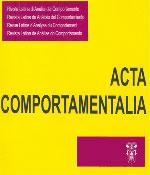Transferência de função por meio de treino discriminativo e contiguidade temporal entre estímulos
DOI:
https://doi.org/10.32870/ac.v27i3.70624Palabras clave:
discriminative training, function transfer, functional classes, contiguity, humans.Resumen
Discriminative training and temporally contiguous stimuli presentation can both produce transfer of functions. The purpose of the present experiment was to investigate whether the temporally contiguous presentation between stimuli or discriminative training would be exclusively responsible for transfer of function. Both procedures were simultaneously presented in a manner that performances produced by each would be the opposite (transfer of function or absence of transfer). Six undergraduates were submitted to three experimental phases. The first phase consisted of a discriminative training. Six compound stimuli were successively presented. Each compound stimulus was formed of A1 presented side-by-side with one of six other unitary stimuli from two different sets of stimuli. The compounds were A1B1, A1C1, A1D1 (Set 1) and A1B2, A1C2, A1D2 (Set 2). Each compound was presented for four seconds separated by an Inter Trial Interval of two seconds. Participant could click with the mouse or not click in the presence of each compound. Responding in the presence of A1B1, A1C1, A1D1 and not responding in the presence of A1B2, A1C2, A1D2 was followed by reinforcement. Not responding in the presence of A1B1, A1C1, A1D1 and responding in the presence of A1B2, A1C2, A1D2 was not followed by programmed consequences. In the second phase, B1 and B2 were successively presented. In the presence of each of these stimuli participant could press “tab” key (response R1) or “enter” key (response R2) from the keyboard. These stimuli remained on the screen until R1 or R2 were emitted. At the end of each trial, R1 and R2 were differentially reinforced in the presence of B1 and B2, respectively. Throughout the training phases, points added to a counter were used as reinforcement. The third phase consisted of transfer of function test in which all unitary stimuli were successively presented and responses R1 and R2 were recorded. No programed consequences were presented in testing phase. The participants reached accurate performances after two to eight training sessions in the first phase and reached accurate performances in the second phase after one or two training sessions. The results on the transfer of function test showed that four out of six participants emitted, systematically, R1 and R2, respectively, in the presence of unitary stimuli from Set 1 and 2. The two other participants emitted R1 and R2, unsystematically, in the presence of all stimuli. These results indicated that for four out of six participants functional classes were established by the discriminative training. Therefore, temporal contiguity is not sufficient to produce transfer of function. These results indicated that discriminative training might have a preponderant role in establishing stimuli classes and transfer of function.Descargas
Los datos de descargas todavía no están disponibles.
Descargas
Publicado
3 de septiembre de 2019
Cómo citar
Martins Filho, A., Piovezan, P., Abilio Silva, J., Krasic Alaiti, R., & Debert, P. (2019). Transferência de função por meio de treino discriminativo e contiguidade temporal entre estímulos. Acta Comportamentalia, 27(3). https://doi.org/10.32870/ac.v27i3.70624
Número
Sección
Artículos
Licencia

<a rel="license" href="http://creativecommons.org/licenses/by-nc-sa/4.0/"><img alt="Licencia de Creative Commons" style="border-width:0" src="https://i.creativecommons.org/l/by-nc-sa/4.0/88x31.png" /></a><br />Este obra está bajo una <a rel="license" href="http://creativecommons.org/licenses/by-nc-sa/4.0/">licencia de Creative Commons Reconocimiento-NoComercial-CompartirIgual 4.0 Internacional</a>.






